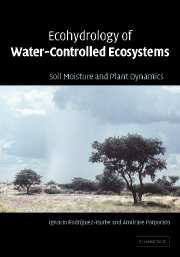Book contents
- Frontmatter
- Contents
- Foreword
- Preface
- 1 Introduction
- 2 Stochastic soil moisture dynamics and water balance
- 3 Crossing properties of soil moisture dynamics
- 4 Plant water stress
- 5 Applications to natural ecosystems
- 6 Coupled dynamics of photosynthesis, transpiration and soil water balance: from hourly to growing-season time scale
- 7 Plant strategies and water use
- 8 Seasonal and interannual fluctuations in soil moisture dynamics
- 9 Spatial scale issues in soil moisture dynamics
- 10 Hydrologic controls on nutrient cycles
- 11 Hydrologic variability and ecosystem structure
- References
- Species Index
- Subject Index
- Plate section
5 - Applications to natural ecosystems
Published online by Cambridge University Press: 14 October 2009
- Frontmatter
- Contents
- Foreword
- Preface
- 1 Introduction
- 2 Stochastic soil moisture dynamics and water balance
- 3 Crossing properties of soil moisture dynamics
- 4 Plant water stress
- 5 Applications to natural ecosystems
- 6 Coupled dynamics of photosynthesis, transpiration and soil water balance: from hourly to growing-season time scale
- 7 Plant strategies and water use
- 8 Seasonal and interannual fluctuations in soil moisture dynamics
- 9 Spatial scale issues in soil moisture dynamics
- 10 Hydrologic controls on nutrient cycles
- 11 Hydrologic variability and ecosystem structure
- References
- Species Index
- Subject Index
- Plate section
Summary
Different water-controlled ecosystems for which valuable and extensive experimental data are available are studied in this chapter using the stochastic description of soil moisture dynamics and vegetation water stress developed before.
Previous chapters have pointed out how some physiological features of plants interacting with soil and climate characteristics may produce very different features in soil moisture dynamics. These are frequently observed in field studies where the intricate interconnection between causes and effects has been found to give rise to the development of strategies for optimum soil moisture exploitation and drought adaptation (e.g., Kemp and Williams, 1980; Sala et al. 1982a,b; Joffre and Rambal, 1993; Larcher, 1995; Linhart and Grant, 1996). Perhaps one of the most typical examples of the links between physiological characteristics of vegetation and soil moisture is the interplay among plant rooting depth, soil moisture fluctuations, and water use efficiency. For example, it was seen in Figure 4.10 that shallow-rooted plants produce high-variance soil moisture dynamics requiring high water use efficiency to exploit the ephemeral soil moisture availability. These high transpiration rates, in turn, cause an even faster decay of soil moisture that further enhances the effect of soil shallowness. The more slowly varying soil moisture dynamics of soils with deep-rooted vegetation seems instead to privilege strategies of careful soil moisture use, which contribute to make soil moisture dynamics even slower (see Section 7.1).
This chapter focuses on some specific water-controlled ecosystems in order to investigate the environmental and physiological origin of their distinctive features.
- Type
- Chapter
- Information
- Ecohydrology of Water-Controlled EcosystemsSoil Moisture and Plant Dynamics, pp. 117 - 178Publisher: Cambridge University PressPrint publication year: 2005



